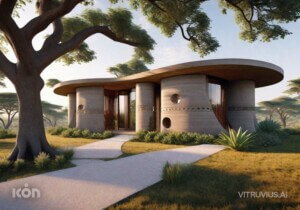The winners of the American Institute of Architects’ (AIA) 11th annual Upjohn Research Initiative have been announced, and $100,000 in grants will be split among the four recipients. Those chosen will receive funding for 18 months to pursue research projects that push the boundaries of design, and their results will be published nationally.
This year’s grant recipients leaned heavily on designs inspired by nature: Half of the group will study the various benefits of biophilia, while another project will examine how biodiversity impacts a structure’s ecological resilience. The 2018 winners are as follows:
- The Impact of Biophilic Learning Spaces on Student Success
Principal Investigators: James Determan, FAIA (Hord Coplan Macht) and Mary Anne Akers, PhD (Morgan State University)
With help from the Salk Institute and Terrapin Bright Green, the team will create a biophilic classroom using patterns and shapes from nature, as well as improved views and natural lighting. The performance of students in the classroom will be measured over time to examine the relationship between biophilic design and the success of the students using it.
- Biophilic Architecture: Sustainable Materialization of Microalgae Facades
Principal Investigator: Kyoung-Hee Kim, PhD (University of North Carolina at Charlotte)
How can algae be integrated into facade systems? That’s what Kim’s team is trying to find out, and the project will involve prototyping a microalgae facade and codifying best practices for using it in the future. These “live facades” have been used to generate heat and algae biomass in past small-scale projects successfully.
- Biodiverse Built Environments: High-Performance Passive Systems for Ecologic Resilience
Principal Investigator: Keith Van de Riet, PhD, Assoc. AIA (University of Kansas)
What are passive architectural systems that architects and designers can use without needing to expend operational energy? Van de Riet’s team will study the integration of biodiversity requirements into the criteria for high-performance passive systems. In this case, a full-scale living wall panel will be installed over an existing seawall in a tidal estuary. The integration of living systems with the built environment will be monitored for both the health of the panel as well as its performance in a stressful, real-world situation.
- Tilt Print Lift – Concrete 3D Printing for Precast Assemblies
Principal Investigators: Tsz Yan Ng (University of Michigan) and Wesley McGee (University of Michigan)
3-D printing concrete has been used to great effect in producing boxy structures, but Ng and McGee will be researching how complicated wall panels can be produced in the same way. The process should theoretically allow wall panel systems to be produced in a variety of shapes and sizes, but the novel, geometric designs will need to be performance-tested before they can be used in the field. The team will also be looking into how 3-D printed panels stack up to precast-produced pieces.
All of the previously published Upjohn research can be viewed here.











